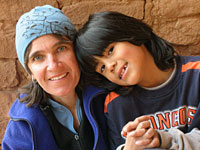



- Viagra
- Sildenafil Citrate (TP)
- Sildenafil Citrate TEVA
- Tadalafil TEVA
- Tadalafil ACCORD
- Tadalafil DAILY
- Vardenafil TEVA
- Vardenafil ZYDUS
- Sildenafil Citrate (GS)
- Cialis
|
Decades-Old Hormone Use Linked to Cancer, Reproductive Problems
2011-12-22
|
Decades-Old Hormone Use Linked to Cancer, Reproductive Problems

WEDNESDAY, October 5, 2011 (Health.com) — Ginny Bank was 14 when her mother sat her down and said they needed to see a gynecologist.
While pregnant with Ginny in the mid-1960s she had taken a synthetic estrogen known as diethylstilbestrol (DES), which at the time was prescribed to prevent miscarriages and complications. Later that decade, however, doctors connected the drug to a rare form of vaginal cancer that was turning up in young women exposed to DES in the womb.
Bank’s first Pap test came back abnormal. Over the next several decades she endured countless abnormal results, biopsies, and preventive surgeries, but fortunately she never developed cancer.
But in her early 30s DES came up in a different context, when she consulted a fertility specialist after trying for several months to get pregnant. “I was filling out a questionnaire before my appointment, and there it was: ‘Did your mother take DES?’” Bank recalls. “Before then, no one had ever told me I’d have a problem getting pregnant.”
Cancer, it turns out, is just one of the potential health problems faced by the millions of women like Bank who were exposed to DES in the womb. According to a new government study published this week in the New England Journal of Medicine, these so-called DES daughters are at higher-than-normal risk for an array of reproductive complications and other problems, including infertility.
Researchers at the National Cancer Institute (NCI) analyzed data from three separate studies that have followed more than 4,000 DES-exposed women since the 1970s. Compared to a control group of unexposed women, DES daughters were found to have higher rates of infertility (33% versus 16%), miscarriage (50% versus 39%), preterm delivery (53% versus 18%), and ectopic pregnancy (15% versus 3%).
The DES-exposed women were also 82% more likely to develop breast cancer after age 40, and more than twice as likely to experience menopause before age 45. For most of the health conditions included in the study, the increase in risk was even greater for DES daughters who had been exposed to especially high doses of the drug.
“Investigators tend to just study disease rather than people. But this actually looks at…the risk for an individual woman who’s been exposed and tells her what exactly it means to her,” says Robert Hoover, MD, the lead author of the study and the director of epidemiology and biostatistics at the NCI, in Bethesda, Md. “When you look at it that way, the numbers are somewhat staggering.”
As many as 10 million people were exposed to DES in the womb between 1938, when the drug appeared on the market, and 1971, when the Food and Drug Administration urged doctors to stop prescribing it. (As if the health fallout weren’t reason enough, researchers had also discovered that DES wasn’t effective at preventing miscarriages.)
Next page: Breast cancer lawsuit under way in Boston





